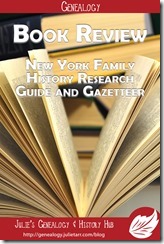 Title: New York Family History Research Guide and Gazetteer
Title: New York Family History Research Guide and Gazetteer
Edited by: Naomi Joshi, et al.
Format: Paperback
Published: 2015
My Rating: ![]()
![]()
![]()
![]()
The following review first appeared in the Federation of Genealogical Societies FORUM magazine (Fall 2016); reprinted with permission.
Note: This review is based on the original edition. A revised edition was released in 2017.
Those who have New York ancestors no doubt understand the challenges associated with researching them. While there are materials out there to assist genealogists with researching in New York, there wasn’t one resource to cover the all challenges statewide—until now. The New York Family History Research Guide and Gazetteer is the “Red Book” for New York, providing numerous details guiding genealogists on their journey to discover their New York ancestors.
The Guide is presented in two parts. The first part contains 17 chapters, 12 of which are dedicated primarily to various record groups. This is where readers will discover the idiosyncrasies associated with New York records, which is necessary in order to understand where to look for and how to use them for successful research. Readers will also discover many gems—those resources that are under-utilized but extremely critical to New York research. Some topics covered in these chapters include: vital records, probate and other court records, military records, tax records, business records, immigration and naturalization records, censuses, and newspapers.
The first chapter in the first part is a little unique in that is gives a historical overview of New York in the colonial era. Chapter 14 discusses New York peoples, providing an overview and resources related to the many ethnic groups associated with New York. Similarly, chapter 15 highlights religious groups, again with an overview and resources related to each.
The final two chapters in the first part are also unique. In chapter 16, readers will find a plethora of statewide repositories, including libraries, museums, and even online resource providers. Each listing includes contact information and an overview of their holdings and/or specialties. Chapter 17 closes out the first part with a list of other reference materials that may be of use to New York researchers.
Each chapter in the first part includes a section called “Selected Bibliography and Further Reading,” which should not be overlooked. While the editors certainly couldn’t provide an exhaustive listing, they did a stellar job in compiling both common and obscure resources that researchers will no doubt find helpful.
The second part is arranged alphabetically by county. Here, readers will find a map of the county, a listing of current and historical place names (gazetteer), and a listing of repositories and resources relevant to the county. The gazetteer is quite helpful since it gives a list of towns and cities along with relevant dates (such as date of settlement), previous names (e.g., the city of Auburn in Cayuga County was settled as Hardenburgh Corners in 1795 before it became Auburn in 1805), a list of villages and settlements within each town, and important notes. Tip: Be sure to read the introduction to the second part to understand terminology and how to use the gazetteer.
Again, while the editors had to be selective in what to include in the listing of repositories and resources for each county, the basics are always provided along with a good collection of other places and resources that genealogists might find helpful. There are online resources listed in the county guides, but keep in mind that records are continuously being added online so this listing, while helpful, may be a little dated.
Following the 62 county guides is a section for New York City, further broken down by borough, and a section for Long Island. These sections are similarly arranged like the county guides, except that a timeline is provided for New York City and each borough.
The Guide concludes with a place name index. This is particularly helpful when the county is not known, or when trying to find a possible variant place name.
Overall, this tome should be in the collection of every researcher with New York roots. I have roots in the eastern and central parts of the state and I have already marked up my copy and added several items to my to-do list. The Guide has certainly restarted my research journey through New York and given me hope that I may find the answers I seek.



Share your thoughts...